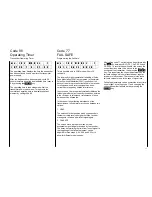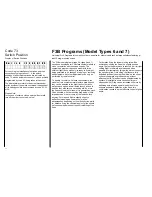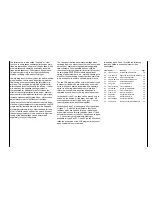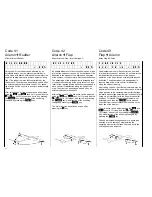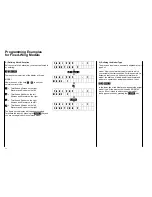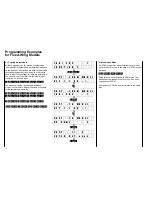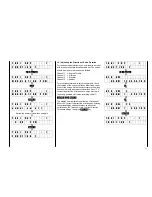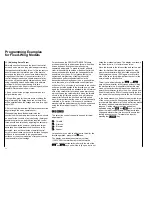
37
The latter set-up is also called “butterfly” or “crow”
function. In some cases separate ailerons and plain
flaps are replaced by one-piece full-span flaps, which
are simultaneously operated as ailerons and plain
flaps (called flaperons). Performance flying means
flying at very low drag, in any flight situation and
attitude, including turns and circling flight.
Lowest drag is achieved only when the airflow hits the
model head-on, that is when side-slipping (with the
flow having a component along the lateral axis) is
avoided. This condition is simplified by differential
ailerons used in conjunction with the aileron – rudder
mix, whereby the negative yawing moment is
compensated for. Additional mixers increase the
effect of the control surfaces (plain flaps – ailerons),
ensure uniform lift distribution (ailerons – plain flaps),
increase manoeuvrability (plain flaps – elevator) and
adjust elevator trim for deflection of the flaps.
In addition to the normal actuation of the plain flaps,
via slider-type potentiometer or a step switch, the F3B
programs offer storable pre-sets for plain flaps and
elevator adjustments for any flight task and for take-
off, all of which can be called via a switch. Which of
the operating elements is to be used for in-flight fine
tuning of the flaps settings can be determined
separately for any of the presets.
The change of the flap and elevator settings when
switching from one preset to another one is not made
abruptly, but achieved using separately adjustable
time constants. Other sensible options, such as
reduction of aileron differential (for butterfly function),
co-switchable PROFITRIM-module with optional
storing of adjustment data, etc., simplify handling of a
model for the demanding contest flyer and assist him
in his endeavour to achieve optimum performance.
The two F3B programs differ only in that model type 6
is meant for flaps which are operated by a common
servo, while each aileron is operated by a separate
servo (in all 3 wing-mounted servos), while type 7
refers to a set-up where each flap and aileron is
operated by its own servo (4 wing-mounted servos).
In the case of type 6, the flaps can be moved only in
unison, so the aileron
flap mixer is omitted. All
other options are alike for type 6 and type 7, so the
two programs may be described together.
Model types 6 and 7 provide nearly all of the options
of types 1…5, with the sole difference that those
functions which are needed for power models only
are omitted, such as throttle reduction (code 17) and
automatic manoeuvre (code 66). As opposed to types
1…5, seven freely programmable mixers are
available for type 6 and 7. Code 23 (switch allocation)
takes the expansion of the F3B program into account
when compared to normal types.
In addition types 6 and 7 provide the following
functions (listed in sequential order of their
descriptions:
Code Display Meaning Page
23
SWITCH FUNCT.
External Switch Allocation 38
52
STRT-SPD-DIST
Flight Trim: Start, Speed, Distance 39
53
FLAP TRIM ASS
Flap Trim Assignment 39
92
SMOOTH SWITCH
Servo Transit Time Set -up 39
41
AILE RUDD
Aileron to Rudder Mix 40
42
AILE FLAP
Aileron to Flap Mix 40
49
FLAP AILERON
Flap to Aileron Mix 40
91
AN. TRIM SW
Set-up for PROFITRIM 42
48
FLAP ELEV
Flap to Elevator Mix 42
47
ELEV FLAP
Elevator to Flap Mix 42
44
BRK ELEV
Spoiler to Elevator Mix 43
45
BRK FLAP
Spoiler to Flap Mix 43
46
BRK AILERON
Spoiler to Aileron Mix 43
54
DIFF REDUCT
Reduction of Aileron Differential 43
Summary of Contents for mc-18
Page 1: ...1...
Page 10: ...Block Diagram NORMAL 10...
Page 11: ...Block Diagram NORMAL DIFF 11...
Page 12: ...Block Diagram DELTA DIFF 12...
Page 13: ...Block Diagram UNIFLY DIFF 13...
Page 14: ...Block Diagram Quadro Flap 14...
Page 15: ...Block Diagram F3B 3 wing servos 15...











